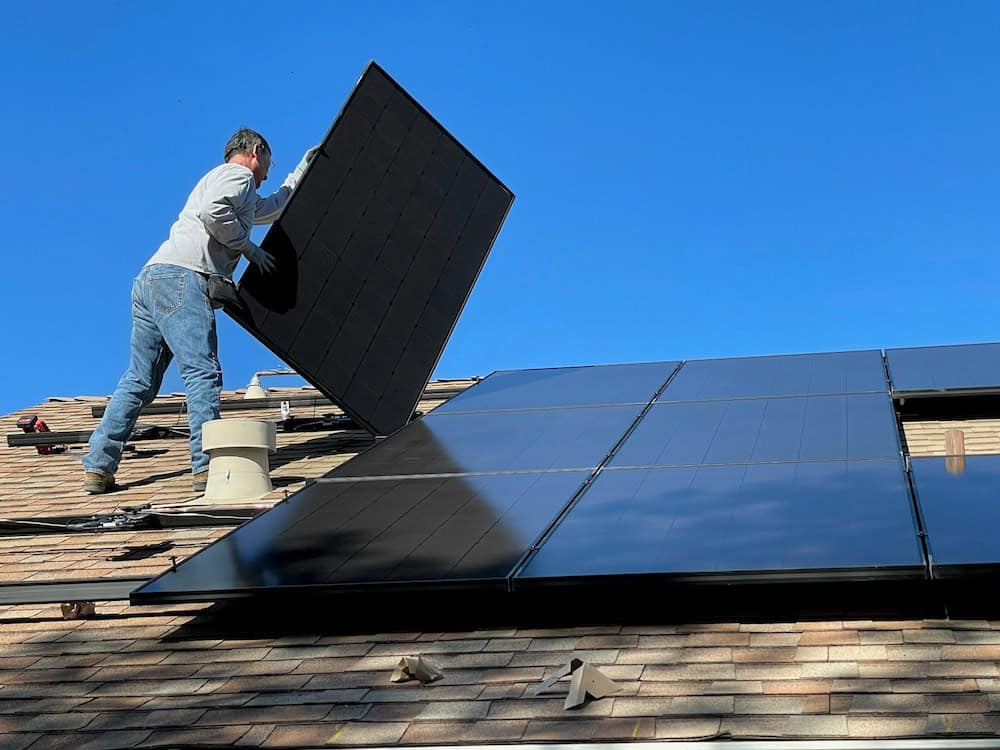Installing a solar panel system at home is a great way to harness the power of the sun and reduce your reliance on traditional energy sources.

In this comprehensive guide, we will walk you through the basic process of installing a solar panel system step by step. From understanding the basics of solar energy to choosing the right components and planning the installation process, we’ve got you covered. So let’s get started!
Understanding Solar Panel Systems
Before diving into the installation process, it’s important to have a good understanding of how solar panel systems work. Solar energy is a renewable energy source that is obtained from the sun’s rays. When sunlight hits the solar panels, it is converted into electricity through a process known as the photovoltaic effect. This electricity can then be used to power your home.
Expanding on the concept of solar energy, it’s fascinating to note that the amount of solar energy that reaches the Earth’s surface in one hour is more than the total energy used by the entire world in one year. This abundance of solar energy presents a vast opportunity for harnessing clean power and reducing our dependence on non-renewable resources.
The Basics of Solar Energy
Solar energy is clean, abundant, and sustainable. It is a renewable source of energy that does not produce harmful greenhouse gas emissions or contribute to air or water pollution. By harnessing the power of the sun, you can reduce your carbon footprint and lower your energy bills.
Moreover, solar energy systems have a long lifespan, typically lasting 25-30 years with minimal maintenance required. This longevity not only makes them a cost-effective investment but also contributes to a more sustainable future by reducing the need for frequent replacements and minimizing electronic waste.
Components of a Solar Panel System
A solar panel system consists of several key components. The most important component is the solar panels themselves, which are made up of photovoltaic cells that convert sunlight into electricity. Other components include an inverter, which converts the direct current (DC) electricity generated by the solar panels into alternating current (AC) electricity that can be used in your home, and a racking system that holds the panels securely in place.
In addition to these components, solar panel systems often include monitoring systems that allow homeowners to track the energy production of their solar panels in real-time. This data can help optimize energy usage, identify potential issues with the system, and maximize the benefits of solar energy utilization.
Evaluating Your Home for Solar Panel Installation
Before installing a solar panel system, it’s important to assess your home’s solar potential and determine the right size for your system.
When considering solar panel installation, it’s crucial to understand the environmental impact of harnessing solar energy. By utilizing solar power, you can significantly reduce your carbon footprint and contribute to a more sustainable future. Solar panels generate electricity by converting sunlight into energy, a clean and renewable resource that helps combat climate change.
Assessing Your Home’s Solar Potential
The first step is to evaluate your home’s solar potential. This involves assessing factors such as the orientation and tilt of your roof, the amount of shading from trees or other buildings, and the available space for installing solar panels. A south-facing roof with minimal shading is ideal for maximizing solar energy production.
Furthermore, understanding the local climate and weather patterns is essential when assessing your home’s solar potential. Regions with more sunlight throughout the year will generally have higher solar energy production, making them more suitable for solar panel installation. Factors such as average daily sunlight hours and seasonal variations in sunlight intensity can impact the efficiency of your solar system.
Determining the Right Size for Your Solar System
Once you have evaluated your home’s solar potential, the next step is to determine the right size for your solar system. This depends on your household’s energy needs, as well as the amount of available roof space. An experienced solar installer can help you calculate the optimal system size based on your energy consumption patterns.
Additionally, it’s important to consider future energy needs when determining the size of your solar system. If you plan to expand your household or add energy-intensive appliances in the future, you may need a larger solar array to accommodate the increased energy demand. By planning ahead and sizing your system accordingly, you can ensure that your solar panels continue to meet your energy requirements in the long run.
Choosing the Right Solar Panels and Inverter
When it comes to selecting solar panels and an inverter for your solar panel system, there are several factors to consider. Investing in solar energy is a significant decision, and choosing the right components is essential for maximizing the efficiency and longevity of your system.
Before making a decision, it’s crucial to assess your energy needs and goals. Understanding how much electricity you consume on a daily basis can help determine the size and capacity of the solar panel system you require. Additionally, consider factors such as available space for installation, sunlight exposure, and local weather conditions to optimize the performance of your system.
Types of Solar Panels
There are several types of solar panels available, each with its unique characteristics and benefits. Monocrystalline panels are known for their high efficiency and sleek design, making them a popular choice for residential installations. Polycrystalline panels, on the other hand, are more cost-effective and offer a good balance between efficiency and affordability. Thin-film panels are lightweight and flexible, making them ideal for irregular or limited spaces.
When selecting the type of solar panel for your system, consider factors such as efficiency, durability, and aesthetics. Consulting with a solar energy expert can help you weigh the pros and cons of each type to make an informed decision that aligns with your needs and budget.
Selecting a Suitable Inverter
The inverter is a crucial component of a solar panel system as it converts the DC electricity generated by the solar panels into AC electricity suitable for powering your home or business. There are different types of inverters available, including string inverters, microinverters, and power optimizers, each offering unique features to optimize energy production.
When selecting an inverter, it’s essential to consider factors such as efficiency ratings, reliability, and warranty coverage. Choosing an inverter with a high efficiency rating can help maximize the energy output of your system, ensuring you get the most out of your investment. Additionally, selecting an inverter that is compatible with your chosen solar panels is crucial for seamless integration and optimal performance.
Planning the Installation Process
Before starting the installation process, it’s important to plan ahead and take the necessary safety measures.
Safety Measures to Consider
Installing solar panels involves working at heights and working with electrical components, so it’s important to take safety precautions. This includes wearing appropriate safety gear, following safety guidelines, and hiring a licensed and experienced solar installer.
Tools Needed for Installation
To install a solar panel system, you will need a range of tools, including a drill, screwdrivers, wire cutters, and a ladder. It’s important to have all the necessary tools on hand before starting the installation process.
Step-by-Step Guide to Solar Panel Installation
Now that you have done all the necessary preparations, it’s time to start installing your solar panel system.
Mounting the Solar Panels
The first step is to mount the solar panels on your roof. This involves securing the racking system to the roof and attaching the panels to the racks. It’s important to follow the manufacturer’s instructions and ensure that the panels are securely and correctly installed.
Installing the Inverter
After mounting the solar panels, the next step is to install the inverter. The inverter should be installed in a well-ventilated area, away from direct sunlight and extreme temperatures. It should also be connected to your home’s electrical system following the manufacturer’s instructions.
Connecting the System to Your Home’s Power Supply
Once the solar panels and inverter are installed, the final step is to connect the system to your home’s power supply. This involves running electrical cables from the inverter to your electrical panel and ensuring that the system is properly grounded. It’s important to have a licensed electrician perform this step to ensure compliance with local electrical codes.
By following this step-by-step guide, you can successfully install a solar panel system at home and start enjoying the benefits of renewable energy. Not only will you be reducing your carbon footprint, but you’ll also be saving money on your energy bills. So why wait? Start harnessing the power of the sun today!



